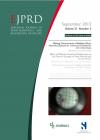European Journal of Prosthodontics and Restorative Dentistry

- Cover Date:
- September 2013
- Print ISSN:
- 0965-7452
- Vol:
- 21
- Issue:
- 3
Effect of Different Chemical Disinfectants on the Flexural Strength of Heat-Polymerized Acrylic Resins
doi:10.1922/EJPRD_1204Nejatidanesh04
Abstract - The purpose of this study was to evaluate the effect of chemical disinfectants on flexural strength of denture base acrylic resins. A total of 176 rectangular specimens(65x10x3mm) were made from four heat-polymerized acrylic resins (Triplex,QC-20, Meliodent and Acropars)(n=44). The specimens were thermal cycled for 5000 cycles 5-55°C and randomly divided into four groups (n=11). The specimens were immersed in 1 % sodium hypochlorite, 2% glutaraldehyde , 10% Micro 10 or water for 30 minutes. The flexural strength was evaluated using a universal testing machine at a crosshead speed of 5mm/min. Data were subjected to 2-way ANOVA and Tukey HSD (α=0.05). The highest flexural strengths of denture base resins were achieved after immersion in water (Triplex =128.9± 12.8, QC-20=125± 11.8, Meliodent=96.2± 11.4 and Acropars=78.1±12.3 MPa). Triplex and QC-20 showed the highest flexural strengths in all of the solutions (P<0.05). The flexural strength of denture base acrylic resins was significantly affected by immersion in disinfection solutions but the reduction in flexural strengths of Triplex, QC-20 and Meliodent after disinfection by %1 sodium hypochlorite, %2 glutaraldhyde and Micro 10 were clinically insignificant.
KEYWORDS: Acrylic resins, Disinfectants, Flexural strength, Polymethyl methacrylate
- Article Price
- £15.00
- Institution Article Price
- £
- Page Start
- 105
- Page End
- 108
- Authors
- O. Savabi, K. Attar, F. Nejatidanesh, H. Goroohi, H. Badrian
Articles from this issue
- Title
- Pg. Start
- Pg. End
- Wetting Characteristics of Addition Silicon Materials Subjected to Immersion Disinfection – An In-Vitro Study.
- 98
- 104
- Effect of Different Chemical Disinfectants on the Flexural Strength of Heat-Polymerized Acrylic Resins
- 105
- 108
- The Effect of Numbers and Locations of Retentive Holes Placed on Master Casts on Reducing the Polymerization Distortion of the Maxillary Complete Denture
- 135
- 140
- Prosthodontic Rehabilitation of a Patient Using a SwingLock Lower Denture after Segmental Mandibulectomy
- 141
- 144
